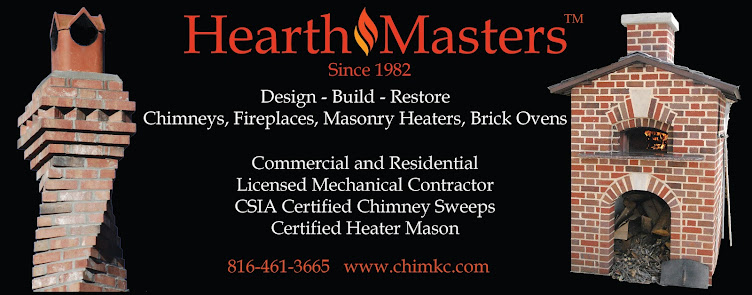By Marge Padgitt
HearthMasters, Inc.
HearthMasters, Inc.
homeowner noticing because the fire often is snuffed out by expanding creosote inside the chimney.
Chimney fires can occur
in chimneys that are connected to wood-burning stoves, open wood-burning
fireplaces, and fireplaces with gas logs installed. It only takes a spark or
heat to ignite creosote.
Fire damage is often found during a routine inspection by a
professional chimney sweep. Signs that a chimney fire has occurred are cracked
or shattered flue tiles; blown out sections of flue tiles; blown out mortar
joints in the flue and smoke chamber; smoke damage to the fireplace face or
other areas of the house; expanded and cracked masonry at the facial wall above
the fireplace opening, back of the chimney, or top of the chimney; a cement cap
that is lifted or broken bond with the top course of bricks; cracks in a cement
cap; damaged chimney cover; or damaged stainless steel chimney with warping or buckled
seams.
Damages to a masonry chimney or steel chimney can be
extensive and very costly to replace, and if the fire escapes the chimney, a house fire can endanger life and property. Avoiding a fire in the first place is
the smartest thing to do.
What are the signs that a chimney fire is occurring? During a chimney fire, the following may occur:
· Loud
roaring or whooshing sound coming from the chimney
· Freight-train
like sound
· Loud cracks
or pops (this is the flue tiles breaking)
· Sudden smoke
backup into the house
· Flames
shoot out the top or sides of the chimney chase
· If not
contained inside the chase, a house fire may occur
What to
do in case of a chimney fire:
· Throw a
chimney fire extinguisher in to the firebox
· Shut off
the air supply by closing glass doors or closing the combustion air intake
· Get the
family out of the house
· Call the
fire department
· Keep
watch for at least 48 hours in case fire ignites again in nearby combustible
framing
· Call a
professional CSIA Certified Chimney Sweep to inspect the chimney and provide an
evaluation report before further use. Be sure to follow the sweep’s advice regarding
any repairs needed. Find a professional chimney sweep at the Midwest Chimney Safety Council site at www.mcsc-net.org or the Chimney Safety Institute of America site at www.csia.org.
How to avoid a chimney fire:
 |
| Wood should be split and stacked at least 6 months before use |
· Have the
chimney inspected and swept on a regular basis by a professional CSIA Certified
Chimney Sweep- once per year for open fireplaces or twice for wood-burning
stoves or inserts.
· Burn only
dry cordwood - get a moisture meter and make sure that there is only 15%
moisture content in the wood.
· Never
burn pine (except hard yellow pine), hedge, railroad ties, wrapping paper, or
treated wood.
· Do not
depend on a chimney sweeping log to remove creosote and do an annual
inspection.
· Use Anti-Creosote-Remover
spray on logs each time you burn to reduce creosote buildup.
· Realize
that all wood creates creosote and maintenance is necessary to remove flammable
creosote.
· Burn hot
fires rather than small or smoldering fires. Smoldering fires create a lot of
creosote buildup and are the primary reason that chimney fires occur.
· Read the
owner’s manual.
______________________________________
Marge Padgitt is the CEO of HearthMasters, Inc. dba Padgitt Chimney & Fireplace in Independence, Missouri. Visit www.chimkc.com or www.hearthmasters.us for more information. Contact Marge at margepadgitt@comcast.net.

